engine YAMAHA PW50 2021 Owner's Manual
[x] Cancel search | Manufacturer: YAMAHA, Model Year: 2021, Model line: PW50, Model: YAMAHA PW50 2021Pages: 82, PDF Size: 1.87 MB
Page 54 of 82
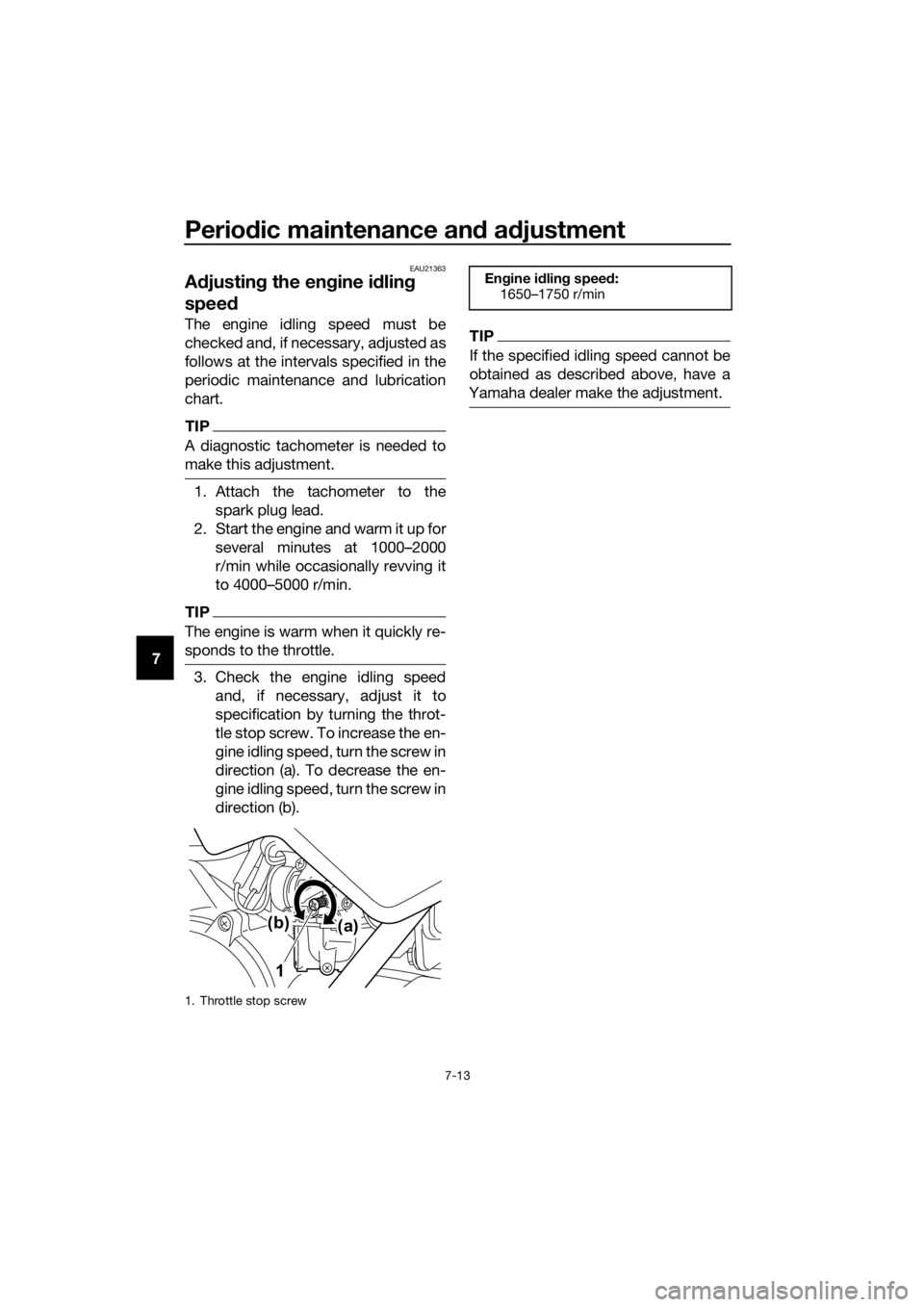
Periodic maintenance an d a djustment
7-13
7
EAU21363
A djustin g the en gine i dlin g
spee d
The engine idling speed must be
checked and, if necessary, adjusted as
follows at the intervals specified in the
periodic maintenance and lubrication
chart.
TIP
A diagnostic tachometer is needed to
make this adjustment.
1. Attach the tachometer to the
spark plug lead.
2. Start the engine and warm it up for several minutes at 1000…2000
r/min while occasionally revving it
to 4000…5000 r/min.
TIP
The engine is warm when it quickly re-
sponds to the throttle.
3. Check the engine idling speedand, if necessary, adjust it to
specification by turning the throt-
tle stop screw. To increase the en-
gine idling speed, turn the screw in
direction (a). To decrease the en-
gine idling speed, turn the screw in
direction (b).
TIP
If the specified idling speed cannot be
obtained as described above, have a
Yamaha dealer make the adjustment.
1. Throttle stop screw
1 (a)
(b)
En
gine i dlin g spee d:
1650–1750 r/min
U2SA87E0.book Page 13 Monday, April 6, 2020 3:00 PM
Page 61 of 82
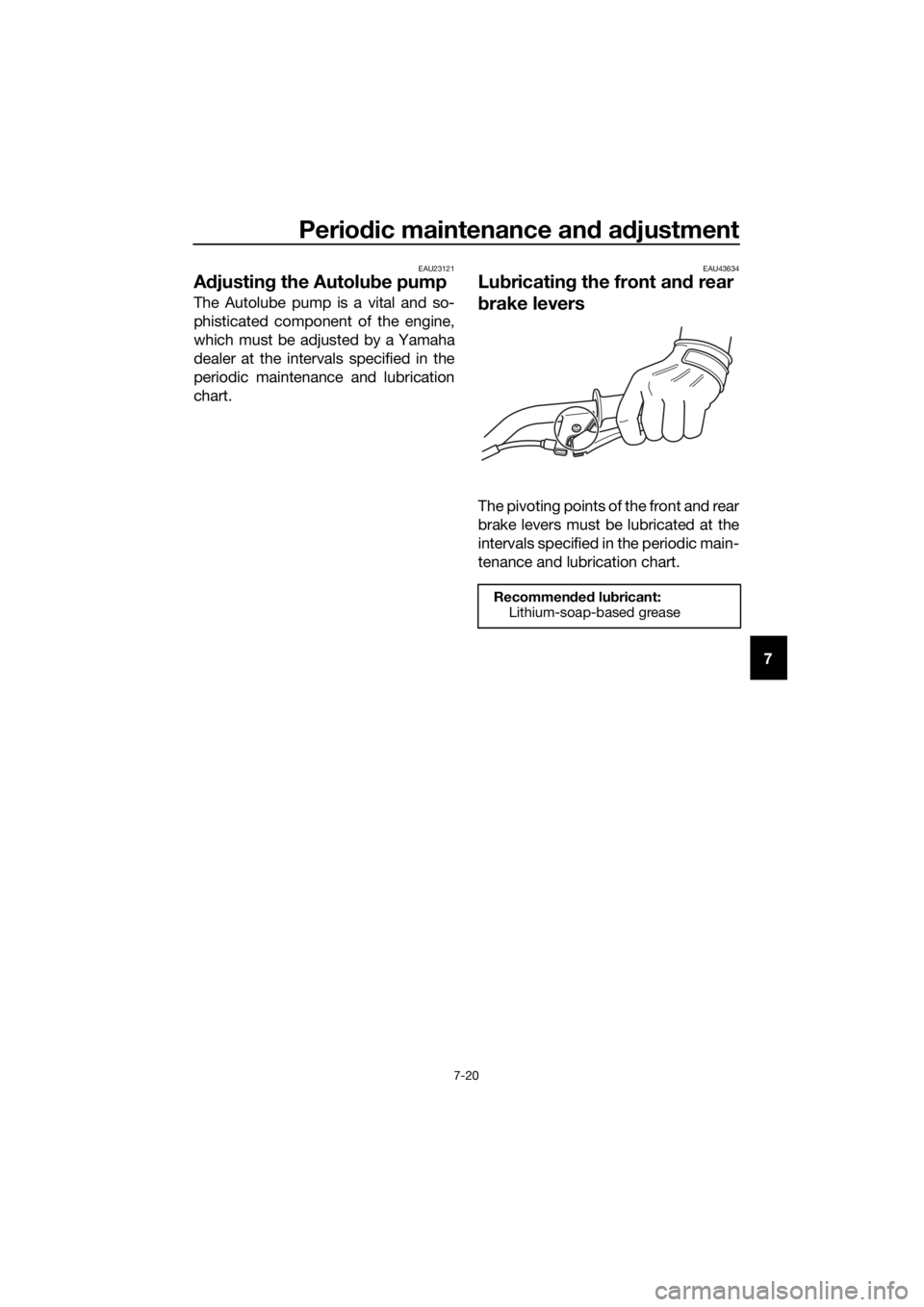
Periodic maintenance an d a djustment
7-20
7
EAU23121
A djustin g the Autolu be pump
The Autolube pump is a vital and so-
phisticated component of the engine,
which must be adjusted by a Yamaha
dealer at the intervals specified in the
periodic maintenance and lubrication
chart.
EAU43634
Lu bricatin g the front an d rear
b rake levers
The pivoting points of the front and rear
brake levers must be lubricated at the
intervals specified in the periodic main-
tenance and lubrication chart.
Recommen ded lu bricant:
Lithium-soap-based grease
U2SA87E0.book Page 20 Monday, April 6, 2020 3:00 PM
Page 69 of 82

Periodic maintenance an d a djustment
7-28
7
EAU68120
Trou bleshootin g chart
1. FuelThere is enough fuel.
There is no fuel.
Check the ignition.
Supply fuel.The engine does not
start.
Check the ignition.
Open the throttle
halfway and operate
the kickstarter.Wipe off with a dry
cloth and correct the
spark plug gap, or
replace the spark
plug.
2. IgnitionWet
Dry
There is compression.
There is no
compression.
The engine does not start.
Have a Yamaha dealer check the vehicle.
Have a Yamaha dealer check the vehicle.
The engine does not
start.
Check the
compression.Have a Yamaha
dealer check the
vehicle.
Remove the spark
plug and check
the electrodes.
Operate the
kickstarter.
Check the fuel level
in the fuel tank.
3. Compression
U2SA87E0.book Page 28 Monday, April 6, 2020 3:00 PM
Page 70 of 82
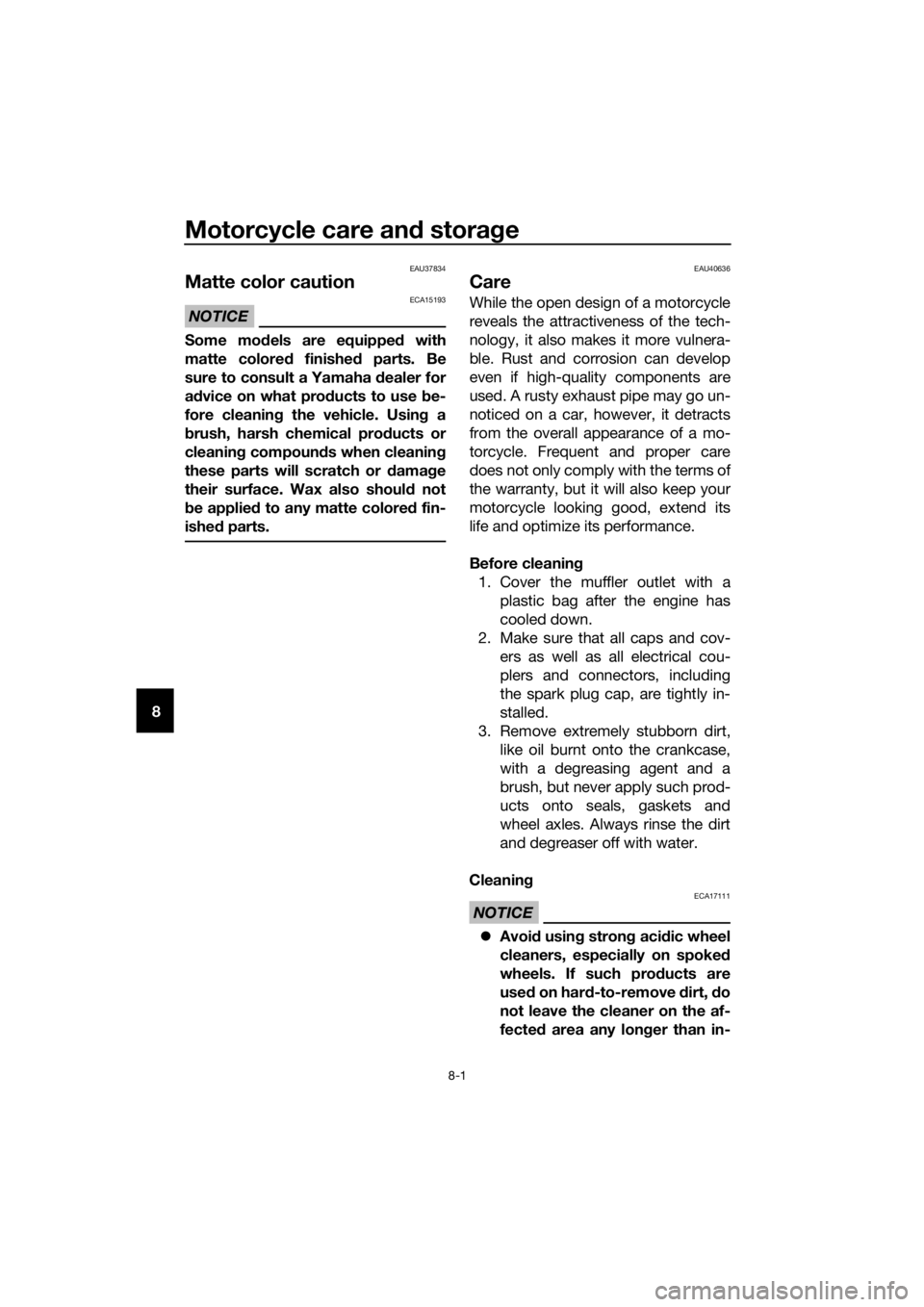
Motorcycle care and stora ge
8-1
8
EAU37834
Matte color caution
NOTICE
ECA15193
Some mo dels are equipped with
matte colore d finishe d parts. Be
sure to consult a Yamaha dealer for
a d vice on what pro ducts to use be-
fore cleanin g the vehicle. Usin g a
b rush, harsh chemical prod ucts or
cleanin g compoun ds when cleanin g
these parts will scratch or damag e
their surface. Wax also shoul d not
b e applied to any matte colored fin-
ishe d parts.
EAU40636
Care
While the open design of a motorcycle
reveals the attractiveness of the tech-
nology, it also makes it more vulnera-
ble. Rust and corrosion can develop
even if high-quality components are
used. A rusty exhaust pipe may go un-
noticed on a car, however, it detracts
from the overall appearance of a mo-
torcycle. Frequent and proper care
does not only comply with the terms of
the warranty, but it will also keep your
motorcycle looking good, extend its
life and optimize its performance.
Before cleanin g
1. Cover the muffler outlet with a plastic bag after the engine has
cooled down.
2. Make sure that all caps and cov- ers as well as all electrical cou-
plers and connectors, including
the spark plug cap, are tightly in-
stalled.
3. Remove extremely stubborn dirt, like oil burnt onto the crankcase,
with a degreasing agent and a
brush, but never apply such prod-
ucts onto seals, gaskets and
wheel axles. Always rinse the dirt
and degreaser off with water.
Cleanin g
NOTICE
ECA17111
Avoi d usin g stron g aci dic wheel
cleaners, especially on spoke d
wheels. If such prod ucts are
use d on har d-to-remove dirt, do
not leave the cleaner on the af-
fected area any lon ger than in-
U2SA87E0.book Page 1 Monday, April 6, 2020 3:00 PM
Page 71 of 82

Motorcycle care and stora ge
8-2
8
structed
. Also, thorou ghly rinse
the area off with water, immed i-
ately dry it, an d then apply a cor-
rosion protection spray.
Improper cleanin g can damag e
plastic parts (such as cowlin gs,
panels, etc.) an d the mufflers.
Use only a soft, clean cloth or
spon ge with water to clean
plastic. However, if the plastic
parts cannot be thorou ghly
cleaned with water, dilute d mil d
d eter gent with water may b e
use d. Be sure to rinse off any
d eter gent resi due using plenty
of water, as it is harmful to plas-
tic parts.
Do not use any harsh chemical
prod ucts on plastic parts. Be
sure to avoi d usin g cloths or
spon ges which have b een in
contact with stron g or a brasive
cleanin g prod ucts, solvent or
thinner, fuel ( gasoline), rust re-
movers or inhi bitors, brake flui d,
antifreeze or electrolyte.
Do not use hi
gh- pressure wash-
ers or st eam
-jet cleaners since
they cause water seepag e and
d eterioration in the followin g ar-
eas: seals (of wheel an d swin g-
arm bearin gs, fork an d b rakes),
electric components (couplers,
connectors, an d switches),
b reather hoses an d vents.
After normal use
Remove dirt with warm water, a mild
detergent, and a soft, clean sponge,
and then rinse thoroughly with clean
water. Use a toothbrush or bottlebrush
for hard-to-reach areas. Stubborn dirt and insects will come off more easily if
the area is covered with a wet cloth for
a few minutes before cleaning.
After riding in the rain or near the sea
Since sea salt is extremely corrosive,
carry out the following steps after each
ride in the rain or near the sea.
1. Clean the motorcycle with cold water and a mild detergent, after
the engine has cooled down.
NOTICE: Do not use warm wa-
ter since it increases the corro-
sive action of the salt.
[ECA10792]
2. Apply a corrosion protection spray on all metal, including chrome-
and nickel-plated, surfaces to pre-
vent corrosion.
After cleanin g
1. Dry the motorcycle with a chamois or an absorbing cloth.
2. Use a chrome polish to shine chrome, aluminum and stainless-
steel parts.
3. To prevent corrosion, it is recom- mended to apply a corrosion pro-
tection spray on all metal,
including chrome- and nickel-plat-
ed, surfaces.
4. Use spray oil as a universal clean- er to remove any remaining dirt.
5. Touch up minor paint damage caused by stones, etc.
6. Wax all painted surfaces.
7. Let the motorcycle dry completely before storing or covering it.
WARNING
EWA14502
Contaminants on the b rakes or tires
can cause loss of control.
U2SA87E0.book Page 2 Monday, April 6, 2020 3:00 PM
Page 72 of 82
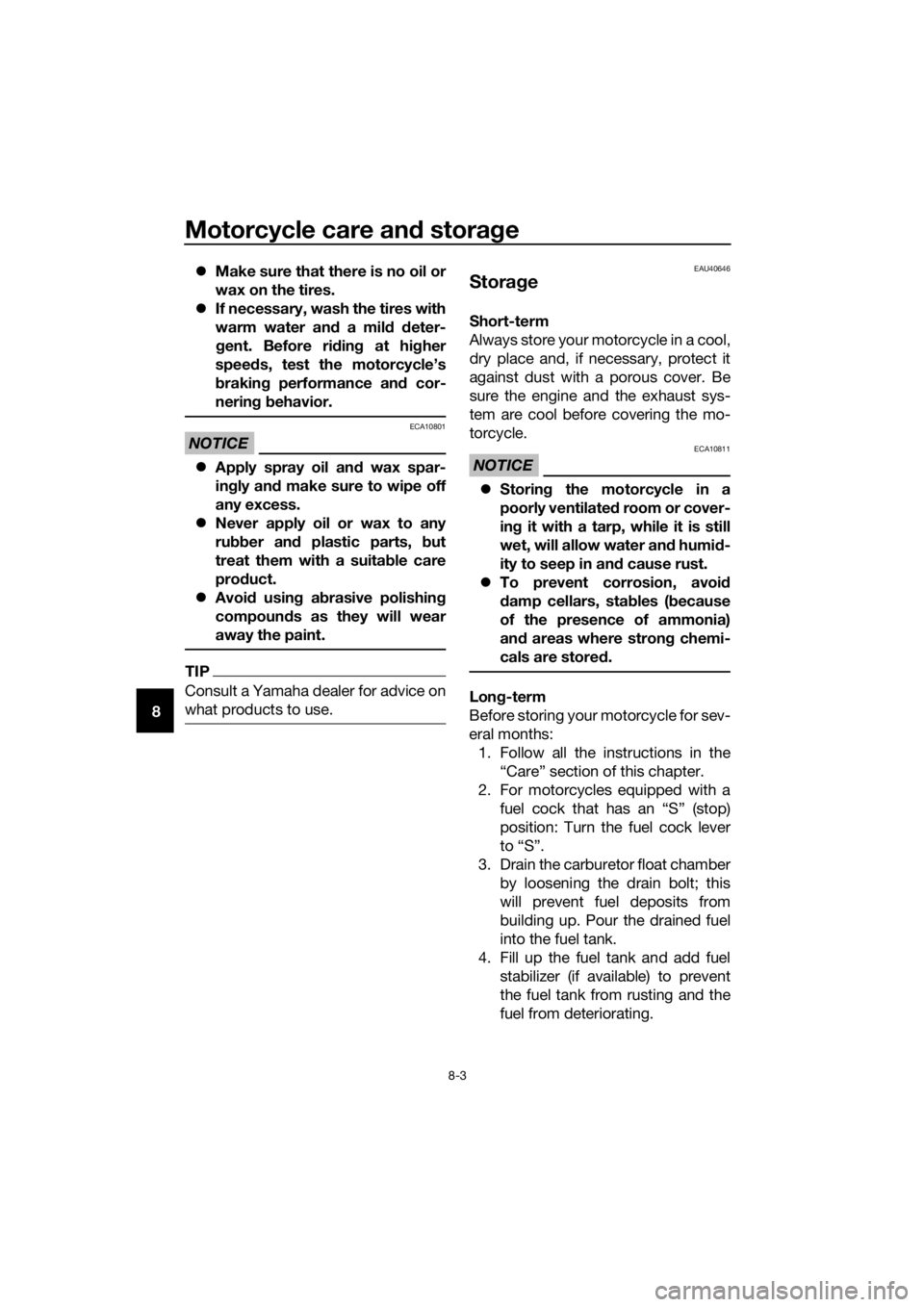
Motorcycle care and stora ge
8-3
8
Make sure that there is no oil or
wax on the tires.
If necessary, wash the tires with
warm water and a mild d eter-
g ent. Before ri din g at hi gher
speed s, test the motorcycle’s
b rakin g performance an d cor-
nerin g b ehavior.
NOTICE
ECA10801
Apply spray oil an d wax spar-
in gly an d make sure to wipe off
any excess.
Never apply oil or wax to any
rubber an d plastic parts, but
treat them with a suitab le care
prod uct.
Avoi d usin g a brasive polishin g
compoun ds as they will wear
away the paint.
TIP
Consult a Yamaha dealer for advice on
what products to use.
EAU40646
Stora ge
Short-term
Always store your motorcycle in a cool,
dry place and, if necessary, protect it
against dust with a porous cover. Be
sure the engine and the exhaust sys-
tem are cool before covering the mo-
torcycle.
NOTICE
ECA10811
Storin g the motorcycle in a
poorly ventilated room or cover-
in g it with a tarp, while it is still
wet, will allow water an d humi d-
ity to seep in an d cause rust.
To prevent corrosion, avoi d
d amp cellars, sta bles ( because
of the presence of ammonia)
an d areas where stron g chemi-
cals are store d.
Lon g-term
Before storing your motorcycle for sev-
eral months: 1. Follow all the instructions in the “Care” section of this chapter.
2. For motorcycles equipped with a fuel cock that has an “S” (stop)
position: Turn the fuel cock lever
to “S”.
3. Drain the carburetor float chamber by loosening the drain bolt; this
will prevent fuel deposits from
building up. Pour the drained fuel
into the fuel tank.
4. Fill up the fuel tank and add fuel stabilizer (if available) to prevent
the fuel tank from rusting and the
fuel from deteriorating.
U2SA87E0.book Page 3 Monday, April 6, 2020 3:00 PM
Page 73 of 82
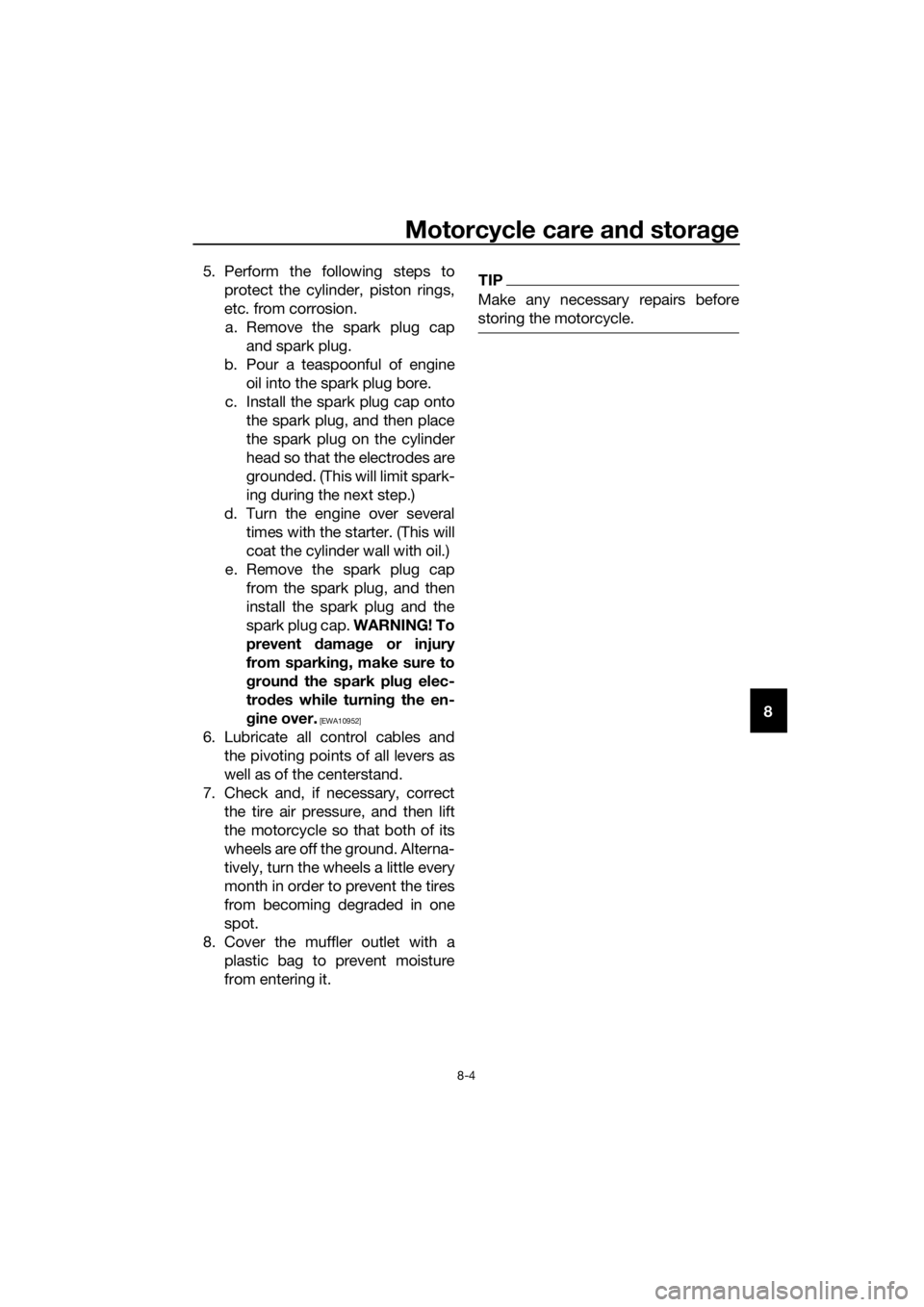
Motorcycle care and stora ge
8-4
8
5. Perform the following steps to
protect the cylinder, piston rings,
etc. from corrosion.a. Remove the spark plug cap and spark plug.
b. Pour a teaspoonful of engine oil into the spark plug bore.
c. Install the spark plug cap onto the spark plug, and then place
the spark plug on the cylinder
head so that the electrodes are
grounded. (This will limit spark-
ing during the next step.)
d. Turn the engine over several times with the starter. (This will
coat the cylinder wall with oil.)
e. Remove the spark plug cap from the spark plug, and then
install the spark plug and the
spark plug cap. WARNING! To
prevent damag e or injury
from sparkin g, make sure to
g roun d the spark plu g elec-
tro des while turning the en-
g ine over. [EWA10952]
6. Lubricate all control cables and
the pivoting points of all levers as
well as of the centerstand.
7. Check and, if necessary, correct the tire air pressure, and then lift
the motorcycle so that both of its
wheels are off the ground. Alterna-
tively, turn the wheels a little every
month in order to prevent the tires
from becoming degraded in one
spot.
8. Cover the muffler outlet with a plastic bag to prevent moisture
from entering it.
TIP
Make any necessary repairs before
storing the motorcycle.
U2SA87E0.book Page 4 Monday, April 6, 2020 3:00 PM
Page 74 of 82

Specifications
9-1
9
Dimensions:
Overall length:1245 mm (49.0 in)
Overall width:
610 mm (24.0 in)
Overall height: 705 mm (27.8 in)
Seat height: 475 mm (18.7 in)
Wheelbase:
855 mm (33.7 in)
Ground clearance: 95 mm (3.74 in)
Minimum turning radius: 1.3 m (4.27 ft)
Wei ght:
Curb weight:
41 kg (90 lb)
Maximum rider weight: 25.0 kg (55 lb)
Technical permissible mass (Maximum load +
Curb weight): 66 kg (146 lb)
Noise an d vi bration level: (Europe)
Noise level (77/311/EEC):
75.1 dB(A) at 2750 r/min
Uncertainty of measurement: 3.0 dB(A)
Vibration on seat (EN1032, ISO5008): Will not exceed 0.5 m/s²
Uncertainty of measurement:
0.1 m/s²
Vibration on handlebar (EN1032, ISO5008): Will not exceed 2.5 m/s²
Uncertainty of measurement: 0.4 m/s²
Engine:
Combustion cycle:
2-stroke
Cooling system: Air cooled
Number of cylinders:
Single cylinder
Displacement: 49 cm³
Bore × stroke:
40.0 × 39.2 mm (1.57 × 1.54 in)
Compression ratio:
6.0 : 1 Starting system:
Kickstarter
Lubrication system: Separate lubrication
Engine oil:
Engine oil:
YAMALUBE 2S or 2-stroke engine oil
(JASO FC grade or ISO EG-C [or EG-D]
grade)
Recommended brand:
YAMALUBE
Engine oil quantity: Engine oil tank capacity:
0.30 L (0.32 US qt, 0.26 Imp.qt)
Transmission oil:
Type:Motor oil SAE 10W-30 type SE or higher or
Gear oil SAE 85W GL-3
Quantity: 0.30 L (0.32 US qt, 0.26 Imp.qt)
Air filter:
Air filter element:
Wet element
Fuel:
Recommended fuel:Regular unleaded gasoline only
Fuel tank capacity:
2.0 L (0.5 US gal, 0.4 Imp.gal)
Car buretor:
Type × quantity:
VM12SC × 1
Spark plu g(s):
Manufacturer/model:
NGK/BP4HS (South Africa)
NGK/BPR4HS (Canada, Europe, Oceania)
Manufacturer/model: DENSO/W14FP-L (South Africa)
Spark plug gap: 0.6–0.7 mm (0.024–0.028 in)
Clutch:
Clutch type:Wet, centrifugal, shoe
Drivetrain:
Primary reduction ratio:
1.909 (63/33)
Final drive: Shaft
Secondary reduction ratio: 6.218 (19/15 x 54/11)
U2SA87E0.book Page 1 Monday, April 6, 2020 3:00 PM
Page 77 of 82

Consumer information
10-1
10
EAU26365
Id entification num bers
Record the vehicle identification num-
ber and the engine serial number in the
spaces provided below for assistance
when ordering spare parts from a
Yamaha dealer or for reference in case the vehicle is stolen.
VEHICLE IDENTIFICATION NUMBER:
ENGINE SERIAL NUMBER:
EAU26401Vehicle i dentification num ber
The vehicle identification number is
stamped into the steering head pipe.
Record this number in the space pro-
vided.
TIP
The vehicle identification number is
used to identify your motorcycle and
may be used to register your motorcy-
cle with the licensing authority in your
area.
EAU26442En gine serial num ber
The engine serial number is stamped
into the crankcase.
EAU48121Vehicle Emission Control Informa-
tion la bel (For Canad a)
1. Vehicle identification number
1
1. Engine serial number
1. Vehicle Emission Control Information label
1
1
U2SA87E0.book Page 1 Monday, April 6, 2020 3:00 PM
Page 80 of 82

11-1
11
Index
A
Acceleration and deceleration ................ 6-3
Air filter element, cleaning .................... 7-10
Autolube pump, adjusting..................... 7-20
B
Brake lever, front .................................... 4-2
Brake lever, rear...................................... 4-3
Brake levers, lubricating ....................... 7-20
Brake shoes, checking ......................... 7-18
Braking.................................................... 6-3
C
Cable lock (for Europe) ........................... 4-9
Cables, checking and lubricating ......... 7-19
Carburetor, adjusting ............................ 7-12
Care ........................................................ 8-1
Centerstand, checking and
lubricating ........................................... 7-21
E
Engine break-in....................................... 6-4
Engine idling speed .............................. 7-13
Engine oil ................................................ 4-6
Engine serial number ............................ 10-1
Engine, starting a warm .......................... 6-2
Engine stop switch ................................. 4-1
F
Front and rear brake lever free play, adjusting ............................................. 7-17
Front fork, checking .............................. 7-21
Fuel ......................................................... 4-4
Fuel cock ................................................ 4-6
Fuel tank breather hose .......................... 4-5
Fuel tank cap .......................................... 4-3
H
Handlebar switch .................................... 4-1
I
Identification numbers .......................... 10-1
K
Kickstarter............................................... 4-7
L
Labels, location....................................... 1-1
M
Maintenance and lubrication, periodic ... 7-4
Maintenance, emission control system .................................................. 7-3
Matte color, caution ................................ 8-1
Middle and final gear cases .................. 7-10
P
Parking .................................................... 6-4
Part locations .......................................... 3-1
Power reduction plate, removing............ 7-7
S
Safety defects, reporting (For CANADA customers) ......................................... 10-3
Safety information .................................. 2-1
Seat ........................................................ 4-8
Spark arrester, cleaning ....................... 7-11
Spark plug, checking ............................. 7-6
Specifications ......................................... 9-1
Speed limiter and power reduction plate ..................................................... 4-1
Starter (choke) lever ............................... 4-7
Starting and warming up a cold engine .................................................. 6-1
Starting off.............................................. 6-2
Steering, checking................................ 7-22
Storage ................................................... 8-3
T
Throttle grip and cable, checking and lubricating .......................................... 7-19
Throttle grip free play, checking........... 7-14
Tires ...................................................... 7-14
Tool kit.................................................... 7-2
Transmission oil ..................................... 7-8
Troubleshooting ................................... 7-27
Troubleshooting chart .......................... 7-28
V
Vehicle Emission Control Information label (For Canada) .............................. 10-1
Vehicle identification number ............... 10-1
W
Wheel bearings, checking .................... 7-22
Wheel (front) ......................................... 7-23
Wheel (rear) .......................................... 7-24
Wheels .................................................. 7-16
U2SA87E0.book Page 1 Monday, April 6, 2020 3:00 PM